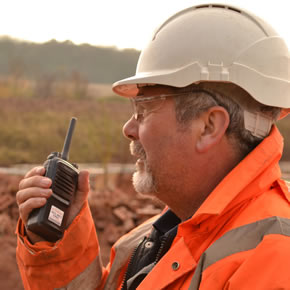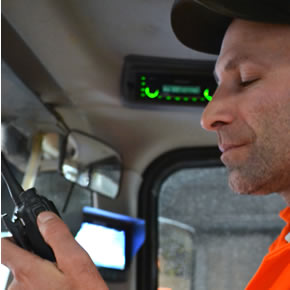
Effective communication in construction: Two-way radios
GUEST BLOG: Ruth Nixon, Managing Director of Zycomm, discusses the role of effective communication in the construction industry, and takes a deeper look at two-way radios along the way.
Technology is changing the world at a remarkable pace, and the communications industry is no exception. It goes without saying that communication is essential to all business activities; and it enables an organisation to improve operational effectiveness.
With traffic and population on an upward trend, the demand for construction doesn’t look like stopping. Good communication is integral to its success, and vital to the effective completion of any construction project. It can help improve teamwork and contribute to a better project, whereas poor communication can often result in delays and problems in the production.
Communication in construction
Construction projects are often very complex, requiring the active participation and communication of all involved. A construction project has an enormous number of “moving parts”. There are many people involved in the construction process; architects, general contractors, subcontractors, engineers, designers, and suppliers to name a few. A successful project demands that the professionals involved are experienced, have the same mind-set, are team players and most importantly, communicate effectively.
Given that construction is such a fragmented and dynamic sector, the challenges of communicating effectively are great. Nevertheless, addressing communication in the industry can be seen as integral for improving the industry in the future.
It’s important to establish clear lines of communication and determine a chain of command for communication on a construction project. These are typically spelled out in the contract documents.
Choose the best communication method, as we communicate in a number of ways every day, both verbally and nonverbally. Texting, talking on the phone and in person, not to mention sending emails are all effective methods. On the construction site communication on a more practical basis is done through signs, drawings, hand signals and meetings.
As you’d expect, all methods of communication have their advantages and disadvantages.
Two-way radios
Here we look at undoubtedly one of the most important methods: two-way radios. The most obvious point to begin with is that two-way radios improves safety on site, offering instant communications, at the push of a button. Busy and often loud, construction sites are full of hazards that can be easily avoided, and one of the most important tools in keeping everyone safe is good communication. Especially in an emergency, it’s vital to alert everyone quickly and efficiently if there is a danger or risk to their safety.
Two-way radios have emergency features such as – man down, lone worker and emergency button These are very important in meeting safety standards.
Two-way radios also enable people to talk to one person, or a group of people all at once, enabling faster response in important situations.
 They are more efficient and easier to use than mobile, not to mention more reliable, as they don’t lose signal at the wrong moments. They don’t hinder productivity, and there’s no need to take your work gloves off. Multiple staff can be dispatched or relocated promptly without having to be called individually, greatly reducing go-between time! Also, two-way radios can improve site access and control.
They are more efficient and easier to use than mobile, not to mention more reliable, as they don’t lose signal at the wrong moments. They don’t hinder productivity, and there’s no need to take your work gloves off. Multiple staff can be dispatched or relocated promptly without having to be called individually, greatly reducing go-between time! Also, two-way radios can improve site access and control.
Unlike a cell phone, you don’t have to wait for a call to connect, nor do you have to spend time dialling the right number.
They offer clear and reliable audio, allowing the message to be received clearly and be understood.
If you want to communicate via other methods, two-way radios can still help thanks to many featuring text function for short messages.
A construction site is often a very hectic place and as well as many people walking around there is often diggers, cranes and other vehicles being driven within the area. It is not only dangerous to use a mobile phone whilst driving any vehicle it is also illegal. A two-way radio is a simple solution to this issue. They are easy to use whilst driving and perfectly within the law.
They have low operating expenses, as there is no line rental or ongoing costs, just initial hiring costs.
They are incredibly robust and will stand the test of time, with water, dust and splash proof options available for all environments.
Latest news

21st February 2025
ASSA ABLOY EMEIA: Save valuable time and money with a seamless switch to programmable digital keys
In 2025, access management can be a whole lot easier. By making access part of their digital processes, businesses can put time-consuming key management and the cost of changing the locks firmly behind them. Making this switch is a lot easier than many people think, as ASSA ABLOY explains here…
Posted in Access Control & Door Entry Systems, Architectural Ironmongery, Articles, Building Industry News, Building Products & Structures, Building Services, Doors, Facility Management & Building Services, Health & Safety, Information Technology, Innovations & New Products, Retrofit & Renovation, Security and Fire Protection
21st February 2025
Showersave supports industry leaders in addressing Part L and Part G regulations
Showersave has sponsored and participated in a recent Building Insights LIVE roundtable on ‘Water & Energy Saving Innovations in New Build Housing’.
Posted in Articles, Bathrooms & Toilets, Bathrooms, Bedrooms & Washrooms, Building Associations & Institutes, Building Industry Events, Building Industry News, Building Products & Structures, Building Regulations & Accreditations, Building Services, Exhibitions and Conferences, Interiors, Pipes & Fittings, Plumbing, Retrofit & Renovation, Sustainability & Energy Efficiency
21st February 2025
GEZE: The importance of Specifying High Quality Door Closers on Fire Doors
Andy Howland, Sales & Marketing Director at GEZE UK, discusses why specifying high quality door closers on fire doors is important…
Posted in Access Control & Door Entry Systems, Accessibility, Architectural Ironmongery, Articles, Building Industry News, Building Products & Structures, Building Regulations & Accreditations, Building Services, Doors, Facility Management & Building Services, Health & Safety, Posts, Restoration & Refurbishment, Retrofit & Renovation, Security and Fire Protection
21st February 2025
Insight Data achieves ISO9001 recertification with zero non-conformities
Leading industry data specialist, Insight Data, has successfully achieved the prestigious recertification for ISO9001 with zero non-conformities for the fourth consecutive year.
Posted in Articles, Building Industry News, Building Regulations & Accreditations, Building Services, Information Technology, Research & Materials Testing
 Sign up:
Sign up: